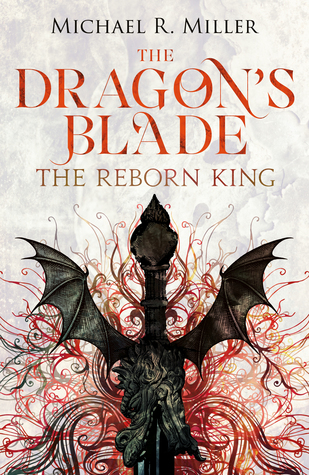
Today, I am very excited to introduce readers to Michael R. Miller, whose first fantasy book, The Dragon’s Blade: The Reborn King, just came to my attention. This author bravely volunteered to reveal how world building factored into his writing process and his method of handling such a tremendous task. So without further introduction, here is Mr. Miller’s guest post, simply entitled WORLD BUILDING!

WORLD BUILDING
When does world building in fantasy go too far? In a genre defined by unique worlds, cultures and magic, readers expect in-depth world building. It is, however, a misunderstanding to think that these elements are the most important. Story and characters will always be what keeps a reader interested. Incredible characters and plot can shore up thinner world building but rarely will the reverse work.
Writers need to make a fairly deliberate decision on how far they want their world building to go. The hard truth is that no matter how much you create and put into the novel there will always be holes, missing elements, things you forgot to think about. Tolkien took decades creating Middle Earth and writing his works and even he couldn’t think up everything and put it in. Tolkien’s world lacks any sense of economy but the richness of his languages and history make his world feel real. Patrick Rothfuss on the other hand has focused more heavily on his currencies and his economics. Each of these authors played to their strengths and interest. Tolkien was a linguistic professor and Rothfuss loves to talk about how he is a geek for matters of money. Just as strong characters and plot can prop up weaker world building, so too can strong elements of world building prop up weaker aspects.
The thing to remember is, you can’t do everything.
Beyond that, how it works for each writer is likely as varied as each author’s writing process. There are those who plan intricately (Architects) and those who ‘discover’ their way (Gardeners). Both have pros and cons and most writers fall somewhere between these two extremes. Relating this to world building, some authors spend years creating their world (like architects) while others will think of much of it as they go along.
The benefit of adding elements as you go along is that it shouldn’t distract from the story or the characters, however, without a good enough foundation, new world building elements thrown on top of each other will soon fall over like a stack of cards. There is a risk here that contradictions may arise and things won’t piece together properly.
The benefit of planning the world ahead is that you can ensure it is a fully coherent, working world with as much mapped out as you like. It allows you to bring in the extra detail that helps make your world feel real. However, there is a danger called by some as ‘world builders disease’, wherein you spend so much time building this epic world and then feel compelled to get it all across to the reader. In such circumstances the characters or plot may take a back seat while the author throws in information about the world or about topics they have researched, almost as a way of justifying having done all that work in the first place. Too much information will drown the reader. It works on every level, from the large scale political situation to the individual character. For example, you want a character to be a blacksmith. You go off and research all about blacksmithing techniques in the period you are trying to emulate. You come across all these great terms and tools of the trade and then feel that you ought to put all this in. Logically this should make the character and their role in the story feel more realistic. The reality is that over use of technical terms and extreme levels of detail will drag the story down and turn readers off.
This relates to what is called the ‘learning curve’ of a book. Every book has new things the reader has to learn in order to become proficient in the world of that story, from character names, to magic systems and so on. In fantasy we have naturally steeper learning curves than fiction set, for example, in present day London. The steepness of this curve again must be considered carefully. Certain books like Brandon Sanderson’s Way of Kings and Stephen Erikson’s Gardens of the Moon have extremely steep learning curves which can be off putting to certain readers. In contrast, in Harry Potter and the Philosopher’s Stone, the reader begins in our own world with a non-magical family. This eases us into the character of Harry and his situation before throwing all the magical elements at us later and is a much easier learning curve because of it. In writing my first book I wanted the learning curve to be as shallow as possible to encourage readers to continue and not be turned off by a wall of world building. I was also writing with a broad audience in mind and so I aimed for readers inexperienced in fantasy to still be able to pick up the book and understand what is going on.
I definitely fall closer to the side of ‘discovering’ my world as I write, although when I have a new element to add I think carefully about it and take some time to plan it out. My foundation for the dragons was that they would be loosely inspired by ancient Rome. For humanity it was Scottish history. At times I have wished I had world built more substantially but some of my favourite parts of the book have come from moments of inspiration.
In writing fantasy we are blending the familiar and the strange and trying to find the goldilocks zone for a particular book, its audience, and your goals as a writer. I am still learning myself, and always trying to improve, but if I had to give some advice it would be the following. Don’t think you have to do X or Y because this or that author did it. Play to your own strengths and interests, what you like to geek out about, and let that inform your world. Be aware of the learning curve and make a conscious decision on how steep or shallow you want to make it. Do your research when necessary but don’t overload the reader with it. This isn’t academics, it is story telling. It’s an art and it’s hard. Very hard at times. If it were easy or formulaic then everyone would be doing it.
![]()

Michael was born and raised in Ayrshire on the West of Scotland. Being useless at kicking a football around, he often resorted to imagining tales of magic and adventure in which he and his classmates would battle to save the school during their lunch hour. Fortunately for all, such embarrassing tales never made it out of his head and onto paper.
Like many young boys he quickly developed a love for daring knights who battled evil. When this was combined with endless hours playing Age of Empires and watching Lord of the Rings, a love for both history and fantasy was born.
He studied History at the University of St Andrew’s, dabbling in everything from Ancient Rome to Modern Scotland and a good deal of things in between. Graduating in 2014 he moved to London to pursue law. He’d rather forget that. In early 2015 he began to seriously turn attention to writing the fantasy story he had always dreamt of telling.
He had sketched out eight chapters over the years and, although they needed rewriting, they helped plot out the action of the story. He wrote a little each night and, slowly, he found things were improving. At a self-publishing panel event he got speaking with a representative from a hybrid publisher and so far so good. With a pinch of luck he hopes to avoid the phantom cubicle desk of real life pinning him down.
He hopes you enjoy reading Dragon’s Blade as much as he has in getting it from idea to page to published book.






A really interesting article. I reviewed this book a while ago on my blog and it’s a really good read….apologies for the self blog plug, no is offence is meant. 🙂
LikeLike
Definitely a solid epic fantasy. And no problem about plugging your review of this book, please feel free to link to it so readers can read your opinion. 🙂
LikeLiked by 1 person
If the post has piqued anyone’s interest in the book then here’s my review of The Dragon’s Blade: https://thetattooedbookgeek.wordpress.com/2016/03/22/the-dragons-blade-the-reborn-king-book-review/ Many thanks for allowing me to plug my blog/review, it’s good of you and greatly appreciated.:)
LikeLike
Pingback: The Dragon's Blade | World Building – A General Insight
Taking a peek into an author’s mental workspace is always a joy and a privilege: thanks for sharing this with us! 🙂
LikeLike
Glad you enjoyed!
LikeLike
Reblogged this on TheTattooedBookGeek and commented:
A really great post. 🙂
LikeLiked by 1 person
I found this article through The Tattooed Book Geek’s blog, and this is a really good post. It took me close to a year to fully develop the world in my YA fantasy novel. The idea I originally started with is not the finished product, so I guess I would fall somewhere between an Architect and a Gardner. Hiring a professional editor was the best thing I ever did. The first one I hired pointed out things that I thought were small at first but ended up changing my entire story. I also signed up for a lit agent boot camp that really helped me develop more of the world. I just sent out my first set of query letters last week. **Fingers crossed.** I don’t think readers that leave negative comments about an author’s world building on Goodreds or Amazon truly understand how hard it is to not only write a novel but create an entire world and the characters that live inside of it. Anyone who can do this well deserves a lot of credit.
LikeLiked by 1 person
I looked at the cover and wondered why it looked so familiar to me…turns out it’s one of the books in the upcoming SPFBO2 organized by Mark Lawrence, which the BiblioSanctum will be involved in this year. This is one of the books assigned to us! Thanks for the insight into the author’s writing process.
LikeLiked by 1 person
Reblogged this on turning words into Worlds and commented:
Interesting for all worldbuilders!
LikeLiked by 1 person